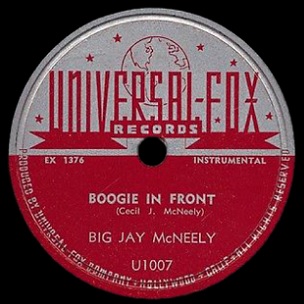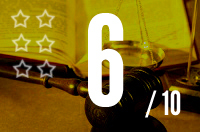Big Jay McNeely: “Boogie In Front”
24 Wednesday Jul 2019
Written by Sampson
Tags
No tags :(
EXCLUSIVE 149X; DECEMBER, 1949

The dominant late 1940’s rock sound was that of honking tenor saxes and the dominant honker among the dozen or more saxophonists plying their trade in this arena at the time was unquestionably Big Jay McNeely.
He wasn’t the first one who raised his horn to the heavens and blew like no tomorrow, nor was he the most prolific in garnering national hits. In fact he got something of a late start compared to many of the others as this release marks his one year anniversary as a recording artist whereas most of the others were closer to hitting the two year point, and some had even surpassed that in other fields before rock came along and gave their ostentatious behavior a sense of purpose, but McNeely had them all beat when it came to the sheer breadth of his output.
But as more and more enter the picture who’ve learned his lessons so well, what’s left to do for the one who defined it so perfectly over the past twelve months?
Down In Front
It goes without saying that instrumental acts are at a disadvantage when it comes to releasing records that highlight an artist’s diversity. Whereas artists who sing can change lyrical topics each time out, not to mention changing their vocal technique, instrumentalists have less to work with.
Yes they can play loud or soft, fast or slow, but without lyrics to distract you the similarities of the musical approaches becomes more evident. When what audiences craved from McNeely was explosiveness, since he’d done it so effectively on his hits, he was always at risk for falling into a repetitive cycle: Load, honk and discharge, then repeat steps 1-3 the next time out and the time after that.
Yet McNeely never gave in to that mentality, something his record labels may not have always been pleased with no doubt, but it speaks to his musical integrity that he was perfectly willing to honk up a storm if that’s what the song called for but he wasn’t merely trying to draw water from the same well each time out.
So while McNeely could be commended for his artistic integrity there also was a downside to that. If it was the ostentatious displays of lung power that drew the most rabid fans what would be the reward for dialing it down and showcasing something more modest? Unless those stylistic change-ups connected with audiences wouldn’t the record companies start insisting on something more outrageous whenever he entered a studio?
Then if he didn’t ascent to those demands, whether they were overt or merely suggested, what would become of chances at continuing to earn a living as a recording artist rather than increasingly being seen merely as a musical museum piece, someone who exemplified a presumably short-lived style from bygone years?
The thing is of course is that from a purely creative viewpoint he was humming right along, the overwhelming majority of his releases were better than average rock records for the era and a good deal of them found limited success, scoring regional hits that probably did enough to keep the company happy without fully bolstering his stature.
For that task he still needed the on-record explosions which is why the promisingly named Boogie In Front was something of a let-down even as there’s not much you can find to criticize about it.
Boogie In The Middle
Maybe the best way to describe this one is as a mid-dance song, by that I mean it’s what you hear when you walk in the club or high school gymnasium at 9:30, a good half hour or more after the dance started when the patrons or students are still under their own power, not fueled by any intoxicating spirits.
These type of songs are energetic enough to keep everybody dancing and good enough to keep those listening more intently to the composition itself entirely satisfied, but they’re not showstoppers, nor are they meant to be. By contrast it’s the songs the band pulls out after midnight when the chemical composition of those on the floor has irrevocably changed, when exhaustion is fended off by exuberance for the increasingly louder and more frantic songs the band is featuring that are the ones you remember… when the potted plant in the corner is being used as a makeshift urinal and the music can’t possibly be too loud, too wild or too exciting to those still on their feet.
By that time Boogie In Front would no longer cut it. The same song that was perfectly acceptable at 9:30 would now send people for the bar, the hallway or the exits.
For McNeely this diversity was necessary. It’s not as if he only played the midnight to 2AM shift at the clubs. Like all working bands their gigs started at 9 and went until the final patron passed out or the law broke down the doors and hauled everyone in on flimsy morals charges.
For Big Jay that meant they couldn’t start out in high gear and keep it up non-stop for five plus hours. They needed these songs to set a steadier groove while hinting at the fireworks still to come.
In that regard this works well. Starting off with piano and horns trading off with some energy before easing back slightly, the song takes a full forty-five seconds before McNeely makes his first real spotlighted appearance. When he comes in he doesn’t disappoint, his playing is impassioned, melodic and reasonably interesting. He employs a series of stutter-steps, playing, pausing and playing again to build excitement without resorting to the kind of musical bomb tossing he was famous for.
Jay’s the best part of this by far, all of his lines are distinctive and seem built to fit seamlessly into any mid-tempo rocker of this era… or for that matter the next two musical eras taking us to the late 1950’s.

Hot And Bothered
I suppose you could say that makes Boogie In Front somewhat generic by nature but things don’t become generic without first becoming popular and this contains much of what audiences of the time found so appealing about rock ‘n’ roll to begin with and sure enough this was a regional hit too (in Dallas). Nothing may break new ground but at least it checks off all of the requirements on the list for it to suffice:
There’s the rhythmic thrust that’s contained in the song carried out mostly in this case by Big Jay himself rather than the rest of the band, as his horn at times takes on a strutting feel that causes your shoulders to groove in step with the notes he’s blowing. Then there’s the piano, the other key instrument, played with a percussive touch by Jimmy O’Brien, who fills in the gaps left by McNeely’s hesitation moves, all while Ted Shirley’s bass is a subtle reassuring presence underneath.

Where the song misses its mark is in its conception as the rest of the horn section carries too much responsibility while lacking a more forward thinking arrangement. It’s not completely dated exactly – although since this was cut way back in February 1949 it’d have a built-in excuse if it were totally out of step – but there’s a conservatism in their parts that might fit musically but falls short in terms of attitude.
Their pedestrian swaying in the extended intro doesn’t have you really anticipating the excitement that McNeely’s arrival promises and when they return to that in the last 50 seconds after Big Jay steps aside you return to your seats, already talking to whomever you’re with about what desert you want to order, or maybe passing along some juicy gossip you heard on your way in.
They never do inject any life into their parts, only Streamline Ewing’s slide trombone stands out just a little and that’s more attributable to the unique tones of the instrument than anything specific he’s playing. When Bob McNeely closes it out on baritone, rather than letting little brother Jay come back for one last hurrah, you nod your head, maybe offer a polite round of applause, but you’re already looking to the next song to see if that might liven things up even more.
Pedestrian Crossing
That’s the problem with being such a magnanimous bandleader at times. McNeely was never reluctant to let his crew take center stage for long stretches and while their individual roles here might not be highlighted, their collective presence takes up too much of the run time for the record’s own good.
Big Jay’s standalone spot – just under one full minute – is high quality stuff as usual and there are some lines he throws in which push it just beyond the break-even point. He’s what you’ve come for and there’s no question when he’s around he fulfills his duty and gets you on your feet.
But that’s not quite what you’ll remember when it’s over, not because of any shortcoming of Jay but simply because too much of what else is offered up is frankly sort of mundane yet still catchy enough that it’ll stick in your head when it’s over.
So it becomes a tale of two records, the sections are not at odds musically with one another by any means but where McNeely’s engine is purring nicely the rest of them are not getting enough gas to the carburetor to really keep them moving.
Still, if we eliminate expectations that go with seeing the name Big Jay McNeely on a record label there is no real disappointment to hearing Boogie In Front. It’s a pretty solid record, just not a great one, but as we know when McNeely’s involved we can’t temper our expectations heading in and so anything short of great feels like a missed opportunity.
SPONTANEOUS LUNACY VERDICT:

(Visit the Artist page of Big Jay McNeely for the complete archive of his records reviewed to date)
